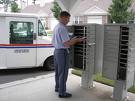We live in magical times. For a reasonable monthly fee, using a device that is better and cheaper every time I buy a new one, I can use the Internet to get access to messages, music, movies, news, porn (ahem, if I wanted it), and an amazing array of other things almost instantly from the comfort of my home.
Woe betide you though, if you live in a isolated area where you don’t have access to high-speed Internet service. You can still get access via your plain old telephone lines, but that service is so slow that downloading anything more than basic text is too painful to contemplate.
Something just as magical serves even the most isolated areas of the country, though it’s been going on for so long that we take it for granted. For a tiny fee, I can have a person pick up actual physical messages, music, movies, news, porn (ahem, if I had any), and an amazing array of other things, and have those items delivered within a day or two anywhere in the entire country, whether it’s somewhere in the middle of a huge city, or somewhere out in the woods of Vermont. And anyone can have any of those things delivered to me, using that same service. We don’t have to worry about compatible computers or deciding how to make connections. It’s all taken care of for us.
 That system is, of course, the United States Postal Service.
That system is, of course, the United States Postal Service.
Since 1775, the USPS has been delivering the mail, growing along with the country. Starting in 1896, Rural Free Delivery expanded that service to everyone. Now the USPS is experiencing a fiscal crisis. The Post Office is expected to pay for itself, but revenues are down due to competition from other delivery services and decreases in mail traffic as people make more use of the Internet. The USPS lost $2.8 billion in 2008 and $5.1 billion in 2007 and is projected to lose more than $6 billion in 2009.
Some people want to privatize the Post Office. The USPS provides an important service, ensuring that everyone, no matter how little clout they have, has access to maildelivery. It’s part of the glue that keeps the country together. One thing is for sure. If the USPS is privatized, your grandma in rural Idaho won’t be able to send Christmas cards for 43 cents apiece any more.
But if the USPS is going to survive, it has to change. Like any other business, they have two choices. They can cut costs or increase revenues. Both options are difficult, especially in the current economic climate when all businesses are suffering.
The Post Office is already exploring cost-cutting options. The Post Office is the second largest employer in the country with about 670,000 employees (only Wal-Mart is larger). The USPS is offering an early retirement package to 20% of their workforce, hoping 3 to 5% of those eligible will accept. In many cases, these are people who applied for their jobs looking for secure lifetime employment, so they’re not going to leave easily, given that similar jobs are hard to find. Another option is H.R. 22, which would allow the USPS to pay for healthcare benefits for current retirees out of its Retiree Health Benefit Fund instead of its operating budget. If the House passes H.R. 22, it would save the USPS an average of $3.5 billion per year over the next eight years. From what I can see, they’re just shuffling money around and the actual healthcare expenses don’t change, but what do I know.
Anyhow, if we take a look at the other side, revenue enhancement, we find that there’s one class of postal customer that gets an even better deal that your grandma in Idaho. That’s the “Standard Mail” customer, or as we all know him, the junk mailer. Junk mail is pre-labeled and sorted by the sender to reduce costs for the post office. Delivery is slower, and Standard Mail is not forwarded if you move. In return, the junk mailer gets a special, extremely low rate.
 The USPS posts their revenue numbers online. Looking at the numbers from 2008, the USPS delivered about 91.7 billion pieces of First Class mail of all kinds (letters, packages, etc…) and took in $38.2 billion dollars, about 42 cents per piece. There were 99.1 billion pieces of “standard” mail, resulting in revenue of $20.1 billion dollars, or about 20 cents per piece. Suppose we raised the Standard Mail rate 10%. A 10% rate hike for junk mail would bring in $3.8 billion dollars. That would help quite a bit. Make it 20% and you’ve covered the projected deficit for 2009. And junk mail would still only cost a little more than half of what it costs to send a piece of First Class mail.
The USPS posts their revenue numbers online. Looking at the numbers from 2008, the USPS delivered about 91.7 billion pieces of First Class mail of all kinds (letters, packages, etc…) and took in $38.2 billion dollars, about 42 cents per piece. There were 99.1 billion pieces of “standard” mail, resulting in revenue of $20.1 billion dollars, or about 20 cents per piece. Suppose we raised the Standard Mail rate 10%. A 10% rate hike for junk mail would bring in $3.8 billion dollars. That would help quite a bit. Make it 20% and you’ve covered the projected deficit for 2009. And junk mail would still only cost a little more than half of what it costs to send a piece of First Class mail.
Of course, it’s not quite that simple. I kept the math simple by treating all the different sizes of mail alike and by assuming that the relative numbers of the different types of pieces remains the same. Non-profit charities send a portion of the junk mail, and we might choose to keep their rates lower (I wouldn’t – they’re some of the most prolific junk mailers). And if the rates went up, there would probably be fewer pieces of junk mail, so the increase in revenue would be less than expected. But most people would see a reduced amount of junk mail as a major benefit!
The United States Postal Service is worth saving. They have to do a big part of the job themselves by becoming more efficient and less of an employment service, so they can react better to changing times. But if it takes raising the price of junk mail delivery to help the Post Office survive, that’s a small price to pay.


Be aware of what you can do: support H.R. 22 (which both the Post Offic and the postal unions support) and oppose the move to eliminate the congressionally mandated 6 days a week delivery service we’ve enjoyed for over 30 years.
Pu-leeze. With mail volume dropping precipitously, raising prices will only cause a further decline. As for changing the law to allow retirement benefits to be funded as incurred only moves when the money is spent.
We can start a real effort to save the Post Office by severely cutting its workforce, which now employs more people than any single US Military Service. If we cut out all post offices serving less than 1,000 residents, slash home delivery to three days per week, throw out the union, impose significant cuts in hourly pay rates, and bring health insurance/retirement benefits in line with private industry . . . then, and only then, will the taxpayer and the postal service survive.
The Post Office would have you believe that it is self-sufficient, but you have to ask: “Who pays for the $19 billion in losses recorded by the service in the past four years?
The postman eventually will go the way of the milkman and the door-to-door salesman. In this electronic age, we no longer require buggy whips.